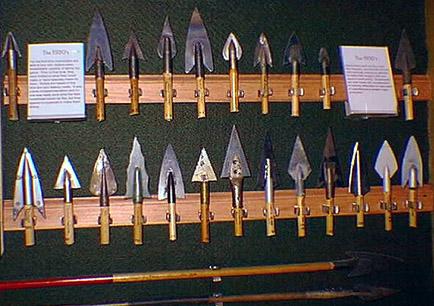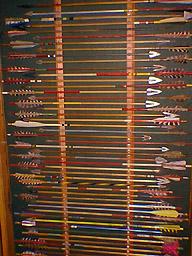One way or another, you will get educated about how much things are
worth (be it monetarily or in trade value). I would prefer to do my homework
enough to lessen the impact of getting "skinned" in a bad trade.
I know that we would like to think that everyone would treat us fairly,
but in reality there are those who will take advantage of you whenever
possible. Thankfully, these people are the exceptions, and word gets around
quickly as to who is not to be trusted. Bowhunting is a small world, and
collecting is even a smaller world. Get your education by doing research.
Subscribe to a few of the trader lists that you find in the traditional
magazines, such as The Footed Shaft in Minnesota. After reviewing several
of these lists, you will soon begin getting a feel for just what some items
are worth in relation to other items. Keep as much of this sort of "documentation"
as you can find for future reference. And remember, all these lists just
offer an opinion of values, real value is determined by how much someone
will pay for an item, not by how much someone is trying to sell it for.

Where Do I Find Items To Begin My Collection?
The old stand-bys, such as garage sales and flea markets still turn
up a lot of really great items, but the days of finding $5 recurves are
over for most of us. I rarely find anything here in Indiana at flea markets
that isn’t just plain junk. It seems that someone has always been
there just before me to get everything. I can’t wait to catch whoever
this is! Seriously, give it a try. I know a fellow in North Carolina who
last year found a wooden arrow box in a flea market that had belonged to
Art Young! In the box were several of Art’s Signature series broadheads,
which rate as one of the best there are among broadhead collectors. It
still happens, just not to me.
Old time bowhunters are one of the best sources for goodies. Surely
you know of someone, or know of someone who knows someone who bowhunted
back in the 40’s, 50’s, even 60’s. Go talk with them, let
them know how eager you are to preserve the history of this sport. They
might just be thrilled to find someone who cares.
Also, try the internet. There have been some good items traded and sold
on the Bowsite’s Classified Section. Although you may be competing
with some pretty savy collectors, I have seen some good items sold way
too cheap in here.
What If I Live In An Area With No Bowhunting Heritage?
I get this question a lot from people in areas like the southeast, or
southwest. This is true, there may not have even been a bowseason in your
area until the last few years, and in this case the chances of finding
an old bowhunter, or a shop that has been around for years are pretty slim.
But I guarantee you that there are used bookstores in every corner of the
country who can do book searches for you even if they don’t have any
themselves. These books can then be traded for almost anything that you
do want. The main thing is: Don’t Give Up!!!! Be creative.
Hint: There are some great finds being turned up in the retirement
areas, where old bowhunters from the upper midwest have gone to spend their
golden years.
How Much Should I Pay For An Item When I Find It?
Unlike other hobbies, such as coin and stamp collecting or even fishing
lures, there are no official price guides for archery collectors. Worse
yet, items vary in value according to geography. For example, a 1950’s
vintage Bear Catalog might bring $35-$50 in the midwest where they are
more likely to be found, and as much as $50-$60 in areas such as the Southwest
where chances of finding one are slim to none. But again, be creative.
There are people who publish price lists of items for sale. For the most
part, this has been done with bows, books, and leather goods. Only lately
have people begun publishing "Broadheads For Sale" lists. Begin
by compiling a variety of these lists and soon you will have your own reference
library of relative values for items. For example, you will soon discover
that a 1954 Bear Kodiak II (Compass model) is a very sought after item.
You will undoubtebly find some variation in the price that people are
asking for one, but by comparing the various lists you will soon be able
to determine the relative worth of this bow compared to others and then
it will be easier to determine how much you are willing to pay.

Remember – An item is only worth what someone will actually
pay for it, not what someone is asking for it.
I have seen some items rediculously priced, and other times I have seen
items almost given away. You must be the one who decides if the price is
in the range of what you are willing to pay.
Old archery books are probably the easiest to value. Assuming that the
book has no special factors which would affect it’s value, such as
the autograph of the author, I have found the Internet to be an absolutely
invaluable tool for determining book values. There are many, many sites
on the net which sell used, out-of-print books. You can search these sites
by author, or by title, or some even allow a search by subject. For example,
you could search for all books under the subject of "Archery".
Using these sites, you will soon have a source for several "opinions"
as to what a book is worth.
Hint – Giving away one of my secret pages here, try
www.bibliofind.com. But
always remember what Glenn St. Charles taught me several years ago - no
matter what you saw, I saw it first!!
Broadheads are a different game. There has always been a debate among
broadhead collectors as to the merits of selling heads for cash. Established
collectors in one camp argue that why shouldn’t my collection be worth
something, especially to my wife or kids should they need to sell it after
I’m gone? New Collectors in this same camp argue that there would
be no way that a new collector could ever hope to get some of the better
heads without buying them, especially since the collector’s of day’s
past have already gotten all the best heads from the old timers and shops.
The other camp argues that once heads start acquiring a monetary value,
someone somewhere will start to fake them for financial gain. (It has already
happened to a small degree). They also argue that the example set by fishing
lure collecting is not what they want to see broadhead collecting end up
as, where only the collectors with the most money can get the better heads.
As you can see, it’s a tough call. Both sides have great arguments.
You will have to be the judge of this one. But understand these arguments
before you approach that older, established collector to purchase heads.
He just might be offended by your offer. My opinion, should you care, is
that I don’t sell heads simply because it is much too hard to find
the better ones. And I like the fact that I can put a value on my heads
if for no other reason than to make my insurance man happy.
After having said all this, what are broadheads worth? If you go by
the few people who are selling the better heads, you will find that they
range from $1 for the most common heads, to a top price of around $500
for the rarest of the heads. For example, the first commercially available
broadhead was the Peck & Snyder which was produced in 1878. There are
only 2 of these heads known in collections. A combination of this rarity
and the fact that it was the first broadhead sold to bowhunters would probably
put this head in the upper range of these estimates if it were ever made
available for sale. Another example would be the Art Young Signature broadhead.
Art died before this head made it out of the prototype phase, and only
around 200 were known to have been produced. The combination of rarity
and historical significance combine to make this head have a value of around
$350 to the collectors who have sold it.
Other heads of significant value would include the Barbed Zwickey (1939)
and Hinged Fang (1960). As with every collectible item, it is a combination
of rarity, historical significance, and asthetics that determine an items
value. And truthfully, sometimes it is the asthetics that is the most important
factor. Take the Pioneer Game Tamer for example (A.K.A – Pizza Cutter).
This head was made less than 30 years ago (1970), it really isn’t
considered rare (maybe a 1000 were made, which makes it scarce but not
rare), yet it commonly brings $75-100 when sold. The only explanation is
it’s uniqueness, every collector simply must have one of these heads
in their collection.
There are some great tools available to help broadhead collectors identify
their heads, such as the ABCC’s Master List, and the four volumes
of the Best of Broadhead which the ABCC sells. In the Master List is a
checklist of every broadhead known to have ever been sold commerically
in the world. Also included are the specifications for those heads, such
as weight, ferrule size, number of blades, who made it and when. The Best
Of Broadhead is a compilation of articles from the ABCC’s quarterly
magazine called the Broadhead. The club compiles the best articles on heads
every 5 years into a new volume.
For more information about the ABCC, email Greg Schwehr at gregory.schwehr@amermsx.med.ge.com
In summary, beginning a collection of archery memorabilia is an absolutely
fantastic adventure. You can expect a thrill that almost (I said almost)
rivals that of a big whitetail buck when you spot your first Grumley bow
or hold your first Art Young Signature broadhead in your hand. But just
as in bowhunting, don’t expect your quest to be easy. You will need
to hunt just as hard to find trophy collectibles as you do to hunt a trophy
animal. Don’t forget that a trophy is in the eyes of the beholder,
and that the patient, persistant hunter is usually the hunter with the
best success rates!
If you have any questions about this subject, or would just like to
talk about archery collecting, you can email me at ghopkins@hsonline.net or call (812)
342-3675 after 6pm. Best of luck to you!